Care Tips for Patio Pots, Hanging Baskets
Some of the suggestions I’ll offer to help you be a better patio gardener will seem like they’re more suited for children. Others will be things you, the veteran gardener might have overlooked for years. I’ll cover them briefly, but I’ll recommend them highly. I’m a big fan of container gardening, so this will be fun.
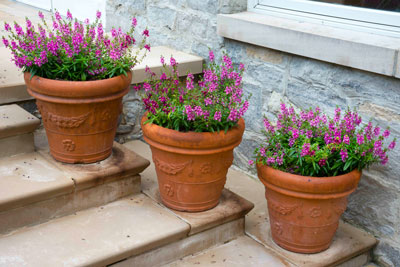
Pots of angelonias highlight these steps.
My tips for success…
• Start with quality containers. We’re blessed with all kinds, from terra cotta to faux terra cotta, concrete to glorious glazed ceramic. There is something for every taste and every need. As you’re buying, think about how the various colors and textures will go with one another.
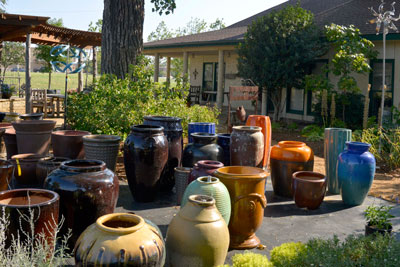
Terra cotta and concrete pots are still the standard. (Shades of Green Nursery, Frisco.)
• Use the best possible potting soil. Here is the mix I’ve repeated hundreds of times on the air, in print and on Facebook. This is what I use for my own pots and baskets:
★ 50 percent (by volume) sphagnum peat moss
★ 25 percent finely ground pine bark mulch
★ 15 percent horticultural perlite *
★ 10 percent expanded shale *
* This ratio is for pots. For hanging baskets, I would reduce expanded shale to 5 percent and increase perlite to 20 percent.
• Position the containers for maximum beauty. Use them near your entryway, along a curved driveway or around the pool or patio.
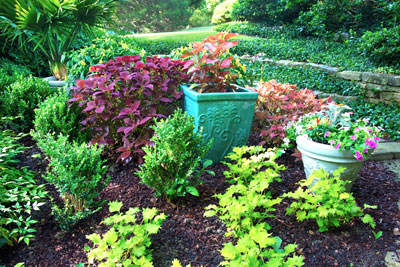
I use many pots in our summertime landscape. These have just been planted.
• Groupings of pots look most interesting. Just one lonely pot sitting in the middle of a bed or patio won’t have much impact. In fact, it may even make things look worse.
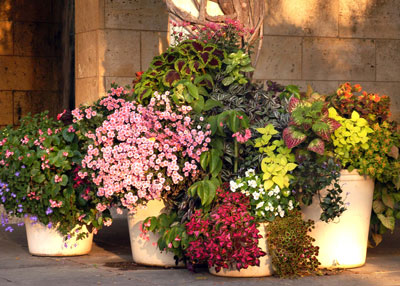
Pots in this photo are harmonious with one another. (Dallas Arboretum, several autumns ago)
• Raise the planters gently off the soil with bricks or small concrete blocks. That will ensure good drainage, and it will keep the plants’ roots from growing out of the drain holes and into the soil and possibly plugging the holes with their roots.
• Choose plants appropriate for the containers you have. They need to be appropriately sized. You’ll want to consider texture and color of both the plant and the pot.
• Choose plants appropriate for the lighting you will be providing. Don’t put sun-loving plants in the shade, and don’t use shade plants in the baking hot sun.
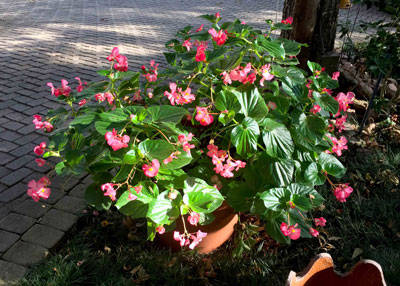
‘Dragon Wing’ begonia requires shade. This plant has happily occupied this spot along our drive for more than two summers now. In the winter it’s in the greenhouse.
• Use a “thriller,” a “filler” and a “spiller.” That’s a popular description of the main vertical plant in the center of your container (thriller), then the plants that fill in around it (fillers), and the plants that tumble over the edges of the pots (spillers).
• Groom your plants regularly to keep them compact and handsome. Pinch out the erratic shoots, also to encourage side-branching. Remove yellowed leaves. Fill voids in large pots with a new plant or two.
• Apply a timed-release plant food. Most types last about two-thirds as long as they claim on the bags or bottles. The coating or encapsulation breaks down faster in our summer heat. If flower or leaf sizes start to diminish, it’s probably time to haul out the plant food (high-nitrogen).
• Supplement the timed-release fertilizer with a diluted, water-soluble food each time that you water. It acts as a booster shot, and the results are remarkable.
• Above all, keep your plants properly watered. Learn what they look like as they just begin to turn dry. Water immediately. Nothing ruins the good looks of patio pots and baskets faster than letting them wilt badly.
Note: This story ran in May 2016 in e-gardens.
